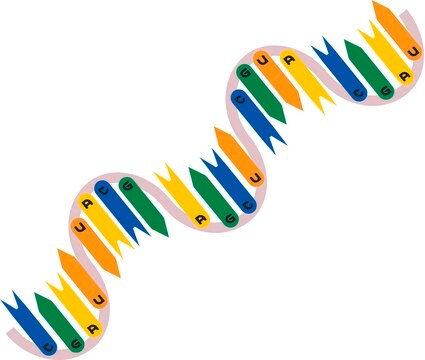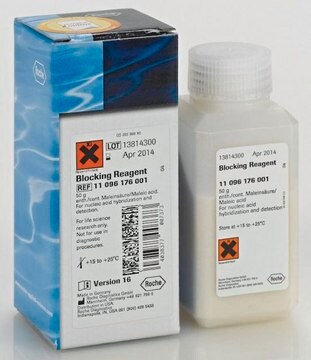R7009
Sty I from Escherichia coli strain carrying pST27
buffered aqueous glycerol solution
Iniciar sesiónpara Ver la Fijación de precios por contrato y de la organización
About This Item
Número de CAS:
Número MDL:
Código UNSPSC:
12352204
NACRES:
NA.53
Productos recomendados
Formulario
buffered aqueous glycerol solution
concentración
10,000 units/mL
Condiciones de envío
wet ice
temp. de almacenamiento
−20°C
Especificidad
Recognition sequence: 5′-C/C(A,T)(T,A)GG-3′
Ligation and recutting results: After 2-10-fold Sty I overdigestion of 1 μg λ DNA substrate, results in 100% cutting, >95% of fragments can be ligated, and >95% recut.
Heat inactivation: Inactivated at 65 °C for 15 minutes.
Ligation and recutting results: After 2-10-fold Sty I overdigestion of 1 μg λ DNA substrate, results in 100% cutting, >95% of fragments can be ligated, and >95% recut.
Heat inactivation: Inactivated at 65 °C for 15 minutes.
Otras notas
Supplied with 10x Restriction Endonuclease Buffer SH (B3657).
Forma física
Solution in 20 mM Tris-HCl, pH 7.5, 0.1 mM EDTA, 50 mM KCl, 10 mM 2-mercaptoethanol, 0.1% gelatine (v/v), 0.01% polydocanol (v/v), 50% glycerol (v/v) at 4 °C
Producto relacionado
Referencia del producto
Descripción
Precios
Elija entre una de las versiones más recientes:
Certificados de análisis (COA)
Lot/Batch Number
¿No ve la versión correcta?
Si necesita una versión concreta, puede buscar un certificado específico por el número de lote.
¿Ya tiene este producto?
Encuentre la documentación para los productos que ha comprado recientemente en la Biblioteca de documentos.
K Mise et al.
Gene, 33(3), 357-361 (1985-01-01)
A new restriction endonuclease, StyI, free of contaminating nuclease activities, has been isolated from Escherichia coli carrying the hsd+ miniplasmid of Salmonella typhi origin. In the presence of 10 mM Mg2+, it recognizes and cleaves a hexanucleotide sequence of 5'-C
C Kessler et al.
Gene, 47(1), 1-153 (1986-01-01)
The properties and sources of all known restriction endonucleases and methylases are listed. The enzymes are cross-indexed (Table I), classified according to their recognition sequence homologies (Table II), and characterized within Table II by the cleavage and methylation positions, the
Cong Zhu et al.
Nucleic acids research, 41(4), 2455-2465 (2013-01-11)
Zinc-finger nucleases (ZFNs) have been used for genome engineering in a wide variety of organisms; however, it remains challenging to design effective ZFNs for many genomic sequences using publicly available zinc-finger modules. This limitation is in part because of potential
Annabel A Ferguson et al.
Methods in molecular biology (Clifton, N.J.), 940, 87-102 (2012-10-30)
The generation of transgenic animals is an essential part of research in Caenorhabditis elegans. One technique for the generation of these animals is biolistic bombardment involving the use of DNA-coated microparticles. To facilitate the identification of transgenic animals within a
TALENs and ZFNs are associated with different mutation signatures.
Yongsub Kim et al.
Nature methods, 10(3), 185-185 (2013-02-12)
Nuestro equipo de científicos tiene experiencia en todas las áreas de investigación: Ciencias de la vida, Ciencia de los materiales, Síntesis química, Cromatografía, Analítica y muchas otras.
Póngase en contacto con el Servicio técnico







